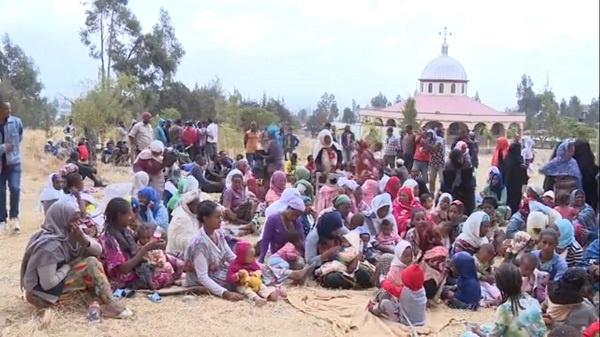
ADDIS ABABA (IOM) – There are now more than 1.8 million internally displaced persons (IDPs) in Ethiopia, a new report on internal displacement released by the International Organization for Migration (IOM) has revealed.
The report, which was completed in September and endorsed by Ethiopian authorities, contains data collected between June and July 2020 through the assessment of more than 1,200 IDP sites and over 1,200 villages where IDPs had reportedly returned.
The primary cause of displacement: conflict, which has resulted in 1,233,557 IDPs across this country. The second highest cause: drought, which displaced 351,062 IDPs, followed by seasonal floods (displacing 104,696 IDPs) and flash floods (50,093).
This is the first time that the Displacement Tracking Matrix (DTM) obtained authorization to conduct its Site Assessment tool in the Southern Nations, Nationalities, and People’s Region (SNNPR) and in the newly established Sidama Region in the country. A total of 93,982 IDPs were found in both regions where 66,994 IDPs (71%) were displaced due to conflict and 26,988 IDPs (29%) were displaced due to flash floods.
The assessment of regions may differ from round to round due to insecurity, road inaccessibility and climate related issues. However, through its Site Assessment, DTM managed to cover the 11 regions of Ethiopia this round which include Afar, Amhara, Benishangul Gumuz, Dire Dawa, Gambella, Harari, Oromia, Sidama, SNNPR, Somali and Tigray.
The report combines findings from both IOM’s Site Assessment which tracks the number of internally displaced persons and IOM’s Village Assessment Survey tool which tracks the number of IDPs who are returning to their communities and needs.
The Village Assessment Survey also assesses the capacity of villages to absorb returns through the availability of services with a focus on livelihoods and reintegration.
The Government has been leading a return initiative since April 2019. This followed as displacement reached a peak of 3.04 million IDPs in March 2019. Through the Village Assessment Survey tool, a total of 1,400,892 returning IDPs were identified throughout the country. A large majority of them (1,328,652 individual or 95 per cent of the total) were initially displaced due to conflict.
IOM Ethiopia has been conducting its Site Assessment tool since 2016 and its Village Assessment Survey tool since June 2019.
“We are happy to continue providing comprehensive and reliable data on internally displaced persons and returning IDPs throughout the country via our National Displacement Report. It is our hope that this data will be well used to inform humanitarian responses and guide policy making,” said Sarah Choong, who is the Acting Coordinator of DTM Ethiopia.
The data and report are used to assist national, regional and local government counterparts in tracking the fluid mobility situation in Ethiopia. IOM’s Displacement Tracking Matrix (DTM) works closely with the National Disaster Risk Management Commission (NDRMC), for its mobility tracking component under which fall the Site Assessment and Village Assessment Surveys. DTM also works with the Ministry of Labor and Social Affairs (MoLSA) for its flow monitoring component which tracks incoming and outgoing migration flows and trends in key locations of high mobility in the country.
Besides the government, the data collected through the Displacement Tracking Matrix is also shared with humanitarian counterparts to inform programming, strategic planning, targeted humanitarian responses and for advocacy purposes. The data is also used in institutional documents, including the Humanitarian Needs Overview and Humanitarian Response Plan.
This round of IOM DTM reporting was made possible through the support of the European Civil Protection and Humanitarian Aid Operations (ECHO), the Government of Germany and the Swedish International Development Cooperation Agency (Sida).
Read the National Displacement Report 5 here.
Source: IOM

Thank you for such valuable report!